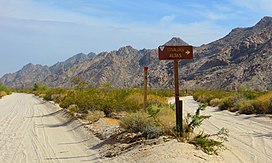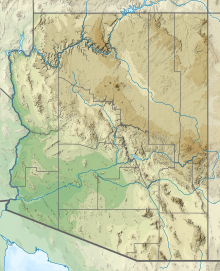| Tinajas Altas Mountains | |
|---|---|
 Sign along
El Camino Del Diablo in
Barry M. Goldwater Air Force Range, near
Wellton, Arizona, at spur road to Tinajas Altas. | |
| Highest point | |
| Peak | Unnamed, 32°16′26″N 114°02′48″W / 32.27389°N 114.04667°W |
| Elevation | 843 m (2,766 ft) |
| Dimensions | |
| Length | 35 km (22 mi) |
| Width | 6.4 km (4.0 mi) |
| Geography | |
| Countries | United States and Mexico |
| State | Arizona |
| Regions | Sonoran Desert, Yuma Desert and Gran Desierto de Altar |
| District | Yuma County, Arizona |
| Settlement | Fortuna Foothills, Arizona |
| Range coordinates | 32°17′00″N 114°03′00″W / 32.2833333°N 114.05°W |
| Borders on | Gila Mountains (Yuma County), Yuma Desert, Lechuguilla Desert and Gran Desierto de Altar |
| Geology | |
| Type of rock | granite–(light-colored) |
The Tinajas Altas Mountains ( O'odham: Uʼuva:k or Uʼuv Oopad) are an extremely arid northwest–southeast trending mountain range in southern Yuma County, Arizona, approximately 35 mi southeast of Yuma, Arizona. The southern end of the range extends approximately one mile into the northwestern Mexican state of Sonora on the northern perimeter of the Gran Desierto de Altar. The range is about 22 mi in length and about 4 mi wide at its widest point. The highpoint of the range is unnamed and is 2,766 feet (843 meters) above sea level and is located at 32°16'26"N, 114°02'48"W (NAD 1983 datum). Aside from the portion of the range in Mexico, the entirety of the range lies within the Barry M. Goldwater Air Force Range. They lie at the heart of the traditional homeland of the Hia C-eḍ O'odham people.
Geology and geography
Geologically, the Tinajas Altas Mountains are a southeastward extension of the block faulted Gila Mountains, and what are now the Tinajas Altas Mountains were actually considered part of the Gila Mountains until about the middle of the 20th century. The two ranges are separated by Cipriano Pass, also referred to as "Smugglers Pass," about two miles northwest of Raven Butte, 2,694 feet (821 m) which is a notable dark-colored volcanic feature on the eastern flank of the otherwise light-colored granitic range.
The range is named for the Tinajas Altas ("High Tanks"), which are a series of perched waterholes on the range's eastern side approximately four miles north of the international boundary. The waterholes figured prominently in the history of the area as they were for many years the only reliable source of water for many miles. Native Americans, principally the Hia C-eḍ O'odham, also utilized the waterholes as an important camp prior to European settlement. [1]
The range lies in the Lower Colorado subdivision of the Sonoran Desert. This subdivision is sometimes referred to as the Colorado Desert and encompasses much of southeastern California, southwestern Arizona, northwestern Sonora, and northeastern Baja California. The subdivision is characterized by minimal precipitation, and the area around the Tinajas Altas Mountains averages only about three inches of rainfall per year. [2]
Mexican topographic maps and United States Geological Survey (USGS) maps of the region disagree on the name of an adjacent range lying to the southeast of the Tinajas Altas Mountains. In the United States this small range is referred to as the Sierra de la Lechuguilla, but in Mexico they are called the Sierra Tinajas Altas which would suggest that they are a longer extension of the Tinajas Altas Mountains into Mexico. The two ranges, however, share no surface connection so they are not the same. The Sierra de la Lechuguilla/Sierra Tinajas Altas range are instead on a parallel alignment to the southeast of the Tinajas Altas Mountains proper. [3] [4] [5]
The closest community to the Tinajas Altas Mountains is Fortuna Foothills in the east of the Yuma Valley adjacent to the Gila Mountains.
Ecology
The Tinajas Altas Mountains exhibit a variety of flora and fauna species. Among the notable flora present is the elephant tree, ( Bursera microphylla), which species exhibits a contorted multi-furcate architecture. [6]
See also
- Cabeza Prieta Mountains
- El Pinacate y Gran Desierto de Altar Biosphere Reserve
- Lechuguilla Desert
- List of LCRV Wilderness Areas (Colorado River)
- List of mountain ranges of Arizona
- List of mountain ranges of Yuma County, Arizona
- Pinacate Peaks
- Sierra Pinta
- Tinajas Altas (High Tanks)
- Tule Desert (Arizona)
- Valley and range sequence-Southern Yuma County
- Yuma Desert
References
- ^ Broyles, Bill, Luke Evans, Richard Stephen Felger, and Gary Nabhan. 2007. Our Grand Desert: A Gazetteer for Northwestern Sonora, Southwestern Arizona, and Northeastern Baja California. In Dry Borders: Great Natural Reserves of the Sonoran Desert, Broyles, B. and R. Felger, editors. University of Utah Press.
- ^ Sellers, William D. and Richard H. Hill. 1974. Arizona Climate: 1931-1972. University of Arizona Press. Tucson, Arizona.
- ^ U.S. Geological Survey. 1965. Tinajas Altas Quadrangle, Arizona. 15-minute Series (Topographic). Washington, D.C.
- ^ U.S. Geological Survey. 1996. Tinajas Altas Quadrangle, Arizona-Sonora. 7.5-minute Series (Topographic). Reston, Virginia
- ^ Direccion General de Geografia del Territorio Nacional. Mina del Desierto, Sonora. 1:50000 scale topographic map. Mexico, D.F.
- ^ C. Michael Hogan. 2009. Elephant Tree: Bursera microphylla, GlobalTwitcher.com, ed. N. Stromberg Archived 2012-03-07 at the Wayback Machine
